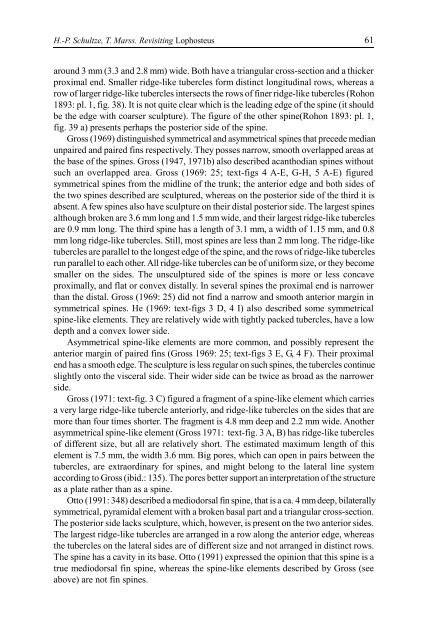Zemes un vides zinātnes Earth and Environment Sciences - Latvijas ...
Zemes un vides zinātnes Earth and Environment Sciences - Latvijas ...
Zemes un vides zinātnes Earth and Environment Sciences - Latvijas ...
Create successful ePaper yourself
Turn your PDF publications into a flip-book with our unique Google optimized e-Paper software.
H.-P. Schultze, T. Marss. Revisiting Lophosteus<br />
61<br />
aro<strong>un</strong>d 3 mm (3.3 <strong>and</strong> 2.8 mm) wide. Both have a triangular cross-section <strong>and</strong> a thicker<br />
proximal end. Smaller ridge-like tubercles form distinct longitudinal rows, whereas a<br />
row of larger ridge-like tubercles intersects the rows of finer ridge-like tubercles (Rohon<br />
1893: pl. 1, fig. 38). It is not quite clear which is the leading edge of the spine (it should<br />
be the edge with coarser sculpture). The figure of the other spine(Rohon 1893: pl. 1,<br />
fig. 39 a) presents perhaps the posterior side of the spine.<br />
Gross (1969) distinguished symmetrical <strong>and</strong> asymmetrical spines that precede median<br />
<strong>un</strong>paired <strong>and</strong> paired fins respectively. They posses narrow, smooth overlapped areas at<br />
the base of the spines. Gross (1947, 1971b) also described acanthodian spines without<br />
such an overlapped area. Gross (1969: 25; text-figs 4 A-E, G-H, 5 A-E) figured<br />
symmetrical spines from the midline of the tr<strong>un</strong>k; the anterior edge <strong>and</strong> both sides of<br />
the two spines described are sculptured, whereas on the posterior side of the third it is<br />
absent. A few spines also have sculpture on their distal posterior side. The largest spines<br />
although broken are 3.6 mm long <strong>and</strong> 1.5 mm wide, <strong>and</strong> their largest ridge-like tubercles<br />
are 0.9 mm long. The third spine has a length of 3.1 mm, a width of 1.15 mm, <strong>and</strong> 0.8<br />
mm long ridge-like tubercles. Still, most spines are less than 2 mm long. The ridge-like<br />
tubercles are parallel to the longest edge of the spine, <strong>and</strong> the rows of ridge-like tubercles<br />
r<strong>un</strong> parallel to each other. All ridge-like tubercles can be of <strong>un</strong>iform size, or they become<br />
smaller on the sides. The <strong>un</strong>sculptured side of the spines is more or less concave<br />
proximally, <strong>and</strong> flat or convex distally. In several spines the proximal end is narrower<br />
than the distal. Gross (1969: 25) did not find a narrow <strong>and</strong> smooth anterior margin in<br />
symmetrical spines. He (1969: text-figs 3 D, 4 I) also described some symmetrical<br />
spine-like elements. They are relatively wide with tightly packed tubercles, have a low<br />
depth <strong>and</strong> a convex lower side.<br />
Asymmetrical spine-like elements are more common, <strong>and</strong> possibly represent the<br />
anterior margin of paired fins (Gross 1969: 25; text-figs 3 E, G, 4 F). Their proximal<br />
end has a smooth edge. The sculpture is less regular on such spines, the tubercles continue<br />
slightly onto the visceral side. Their wider side can be twice as broad as the narrower<br />
side.<br />
Gross (1971: text-fig. 3 C) figured a fragment of a spine-like element which carries<br />
a very large ridge-like tubercle anteriorly, <strong>and</strong> ridge-like tubercles on the sides that are<br />
more than four times shorter. The fragment is 4.8 mm deep <strong>and</strong> 2.2 mm wide. Another<br />
asymmetrical spine-like element (Gross 1971: text-fig. 3 A, B) has ridge-like tubercles<br />
of different size, but all are relatively short. The estimated maximum length of this<br />
element is 7.5 mm, the width 3.6 mm. Big pores, which can open in pairs between the<br />
tubercles, are extraordinary for spines, <strong>and</strong> might belong to the lateral line system<br />
according to Gross (ibid.: 135). The pores better support an interpretation of the structure<br />
as a plate rather than as a spine.<br />
Otto (1991: 348) described a mediodorsal fin spine, that is a ca. 4 mm deep, bilaterally<br />
symmetrical, pyramidal element with a broken basal part <strong>and</strong> a triangular cross-section.<br />
The posterior side lacks sculpture, which, however, is present on the two anterior sides.<br />
The largest ridge-like tubercles are arranged in a row along the anterior edge, whereas<br />
the tubercles on the lateral sides are of different size <strong>and</strong> not arranged in distinct rows.<br />
The spine has a cavity in its base. Otto (1991) expressed the opinion that this spine is a<br />
true mediodorsal fin spine, whereas the spine-like elements described by Gross (see<br />
above) are not fin spines.
















